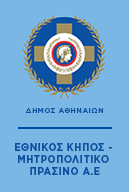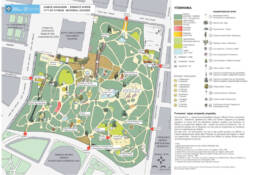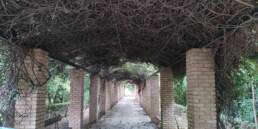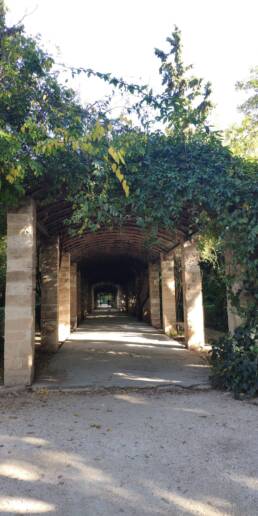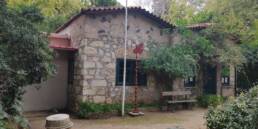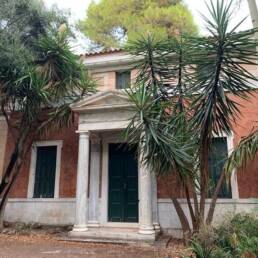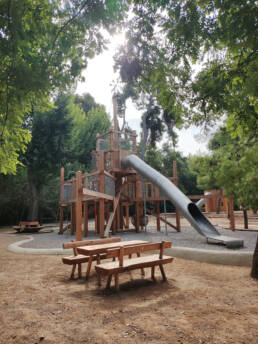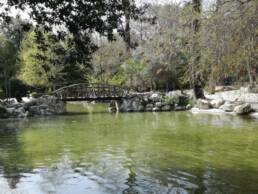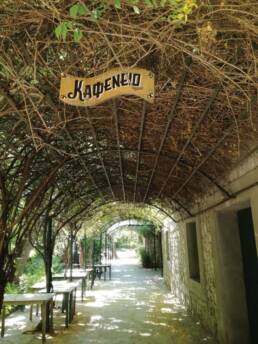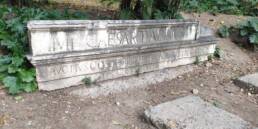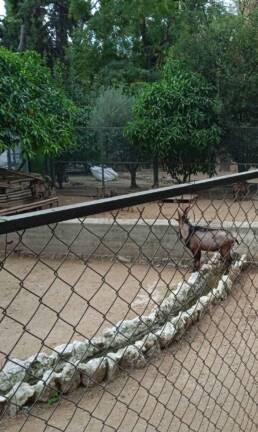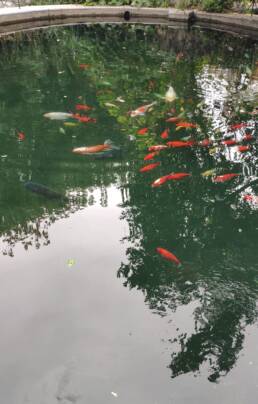National Garden
National Garden
The National Garden is a great example of landscape architecture of the 19th century (English style), which has managed to preserve its basic characteristics unspoiled. The sense of natural landscape, the presence of a complex winding network of paths, the plant units, the intense presence of water, the small-sized flower beds or lawns and its historical plantings are all prevalent to this day and create an oasis in the center of Athens. The National Garden constitutes an important pole of attraction for young and old, Greek and foreign visitors.
Its development and course through time are directly linked to the establishment of the modern Greek state and to the development of Athens into a modern European capital.
Accessibility
The National Garden is open to the public daily from sunrise to sunset.
Access for disabled persons is possible from the entrances of the Garden (except the Vas. Sophias and Jean Morea entrances), while circulation inside the Garden is comfortable and pleasant.
The passage of all kinds of wheeled vehicles (bicycles, electric skates, etc.) with riders is prohibited.
In emergency situations or for security reasons or for any other reason, the opening hours can be modified. In this case, relevant announcements are posted at the entrances to inform visitors or are uploaded on social media.
There are public toilets in the national garden area (see map).
The total area of the National Garden is 156,000 m² and its main entrance is on the Amalia Avenue. Additionally, there are six (6) other entrances:
• An entrance from Vasilissis Sofias Street.
• Two from the Zappeion park area.
• Three from Herodou Attikou Street (two of them are temporarily closed).
HISTORY
The construction of the Royal Garden, as it was called back then, began in 1839 and it is considered the most successful project of Queen Amalia.
A special committee was established for its creation.
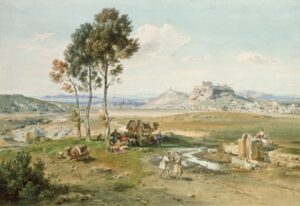
The President of this committee, Professor of Botany Nikolaus Karl Fraas, was responsible for the coordination of the works and the supply of plants. The Garden was initially looked after by the Bavarian agronomist Smarat, assisted by the Prussian gardener Friedrich Schmidt, who succeeded him. Schmidt remained the soul of the Garden until his death in 1889.
In 1847 the original boundaries of the Garden were expanded. It was then entrusted to the French gardener François Louis Bareaud, who designed its network of paths and defined the form and position of its decorative elements, small buildings, water surfaces and fenced areas. The document bearing the design of the Garden, as conceived by Bareaud, is preserved in Munich (in the museum of the community of Ottobrunn). It is a document of rare historical value, a color lithograph entitled “Plan du jardin Royal à Athènes: at a scale of 1:1000 and with full notation of all individual elements.
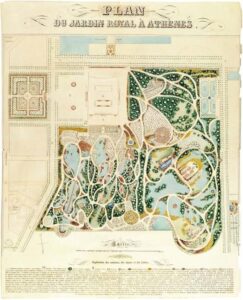 The works were completed in 1852 and, as Nikos Tamvakis, the director of the Garden for decades, writes “if we wanted to place the Garden in one category, we would say that it belongs to one of the variations of the picturesque rhythm, inspired by the ideal of returning to simplicity and nature (the motto was “bring nature into the garden”). Since early 19th century the classical (geometric, French) rhythm, which had its roots in antiquity, had been gradually replaced by the picturesque rhythm.
The works were completed in 1852 and, as Nikos Tamvakis, the director of the Garden for decades, writes “if we wanted to place the Garden in one category, we would say that it belongs to one of the variations of the picturesque rhythm, inspired by the ideal of returning to simplicity and nature (the motto was “bring nature into the garden”). Since early 19th century the classical (geometric, French) rhythm, which had its roots in antiquity, had been gradually replaced by the picturesque rhythm.
The garden was designed according to the early 18th century English style in a “picturesque” or naturalistic manner. Bridges, benches, pergolas, caves and small pavilions, all together compose a freely styled Mediterranean garden, where everything has actually been carefully studied and analyzed.
The National Garden is the only historical garden of Greece and the first landscaped green area of modern Greece. During the first years of its existence, it was the garden of the Palace (today’s building of the Hellenic Parliament). In 1923 it was classified as National and in 1927, the State Legal Entity “Committee of Public Gardens and Trees – National Garden” was founded and in charge until 2004. Since 1927, and for a total of 95 years, the Municipality of Athens has been responsible for managing the National Garden. In 2011, the Garden was officially classified as a Historic Site according to the relevant decision of the Ministry of Culture (Government Gazette 49/23.03.2011). “National Garden – Metropolitan Green S.A.” (Green Athens) was established in March 2020 and took over the management of the area.
BUSTS
Over time, a series of marble busts were placed in the Garden, with the first ones being those of Ioannis Kapodistrias (1866) and the Swiss Philhellene Ioannis-Gabriel Einardo (1866), works by the sculptor Ioannis Kossos.
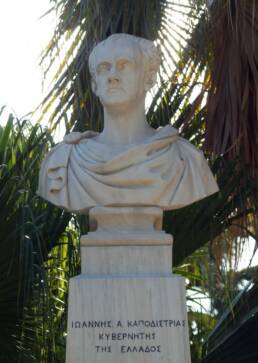
Ioannis Kapodistrias (1776-1831)
The first Governor of Greece is depicted frontally, on a bust larger than natural size, according to the standards of the depictions of the Roman emperors, with a garment that ties to the left shoulder with a buckle. The work is distinguished by the clear contours and idealistic rendering of the figure. The choice of the type of bust and the high base is part of the classical and idealistic tendencies that dominated the West during this period and influenced the work of Kossos. The sculpture was donated by Swiss philhellenes, who wanted to honor Kapodistrias, who, as the representative of Russia, had contributed to Switzerland’s independence and the creation of its federal system; for this reason, he was honored with the Swiss citizenship in 1817.
Sculptor: Ioannis Kossos (1822-1873)
Year of installation: 1866
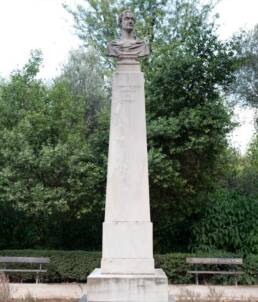
Jean Gabriel Eynard (1755-1863)
The Swiss banker Eynardos was a Philhellene and a personal friend of Kapodistrias. He allocated large sums for the Revolution of 1821 and the Greek War of Independence, as well as for the repayment of the loans of the newly established State. He was the founder of the National Financial Bank, the successor of which was the National Bank.
The bust of Einardos is a gift from his wife and was made by Kossos at the same time as the bust of Kapodistrias. He is depicted on a tall marble column, with the head slightly facing to the right wearing a pleated garment. Marble bust on a marble base.
Sculptor: Ioannis Kossos (1822-1873)
Year of installation: 1866
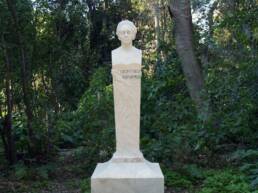
Dionysios Solomos (1798-1857)
Marble bust on a marble column. The bust is a donation of Kostas Eleftheroudakis, who commissioned the execution of the project to Thomopoulos. The inauguration took place on May 30, 1925, by the Mayor Spyros Patsis and the speech was delivered by Kostis Palamas, in the presence of people of the intellect while many schools attended the event. Solomos is rendered frontally, with his characteristic frizzy hair. The face of the marble column adorns diagonally a palm leaf, symbolizing the glory of the poet. The upward lifting of the head, the expression of the poet and the absence of any clothing element removes the work from the classical and academic standards and add spirituality and an emotional charge to the bust.
Sculptor:Thomas Thomopoulos
Year of installation: 1925
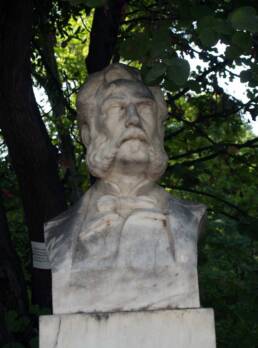
Aristotle Valaoritis (1824-1879)
Marble bust on a marble base. The poet is depicted with intense portrait features, large sideburns, a mustache and rich hair, in an austere style, with his head facing left. He wears a lapel jacket and a bow tie shirt. The bust was donated by Kostas Eleftheroudakis, similarly to the one of Solomos, and the unveiling took place on November 21, 1926, with the delivery of official speeches and the recitation of the poem of Valaoritis “Agrabelin”.
Sculptor:Fokion Rok (1886-1941)
Year of installation: 1926
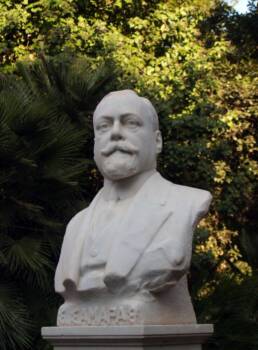
Spyros Filiskos Samaras (1862-1917)
Marble bust on a marble base. The Corfiot composer and creator of the Olympic Anthem (1895-1896), which is heard every time at the Olympic Games all over the world, is depicted with thick mustache and beard, wearing a shirt, tie and jacket. He is facing slightly to the left and gazes upwards. The base, similarly to the base of Solomos’ bust, bears at the bottom an embossed lyre and laurels. Despite the restrictions incurred by the type of work, the sculpture is distinguished for the vitality of expression and the plastic rendering of the volumes. The bust was purchased by the Athens Municipality and was placed in 1920 in front of the Municipal Theatre, where Samaras presented his works. The mayor Spyros Patsis and other officials delivered speeches at the unveiling and a concert with Samaras’ works followed. After the demolition of the Theatre, the bust was placed in front of the National Bank in 1940 and afterwards in its current position in the Garden.
Sculptor:Michalis Tombros (1889-1974)
Year of installation: 1920

Jean Moreas (1856-1910)
Brass bust on a marble base. The bust of the poet Jean Moreas was donated by the poet’s wife and the Greek-French Youth Union and was placed in the Garden in 1963. Jean Moreas came from Athens and his real name was Ioannis Papadiamantopoulos. He left to study in Paris, where he stayed until the end of his life. There he became friends with Bourdelle.
Sculptor: Antoine Bourdelle (1861-1929)
Year of installation: 1963
The biodiversity of the National Garden
• variety of flora and free fauna: flower beds, pergolas with various types of climbing plants, etc.
• free-ranging fauna such as robins and magpies.
• water features such as ponds, fountains and stone irrigation ditches.
6600trees
5700bushes
9400plants
18species of birds
4types of reptiles
3species of amphibians
— The National Garden is a unique landmark of Athens and an important historic garden, distinguished for its design and distinctive aesthetics. It is a place charged historically, with very important environmental functions and at the same time a favorite park for the Athenians.
— We envision the National Garden to continue its course in time as a place of calm and serenity, with its historical identity, biodiversity and other values reinforced / strengthened.
— We envision the National Garden as a place of inspiration, knowledge, innovation and positive influence for the inhabitants of the city.
— To protect, preserve and reinforce the historical character of the National Garden for the benefit of future generations.
— To strengthen the sustainability and resilience of the National Garden.
— To reinforce the participation of all potential stakeholders, through research and educational programmes, voluntary actions and collaborations.
